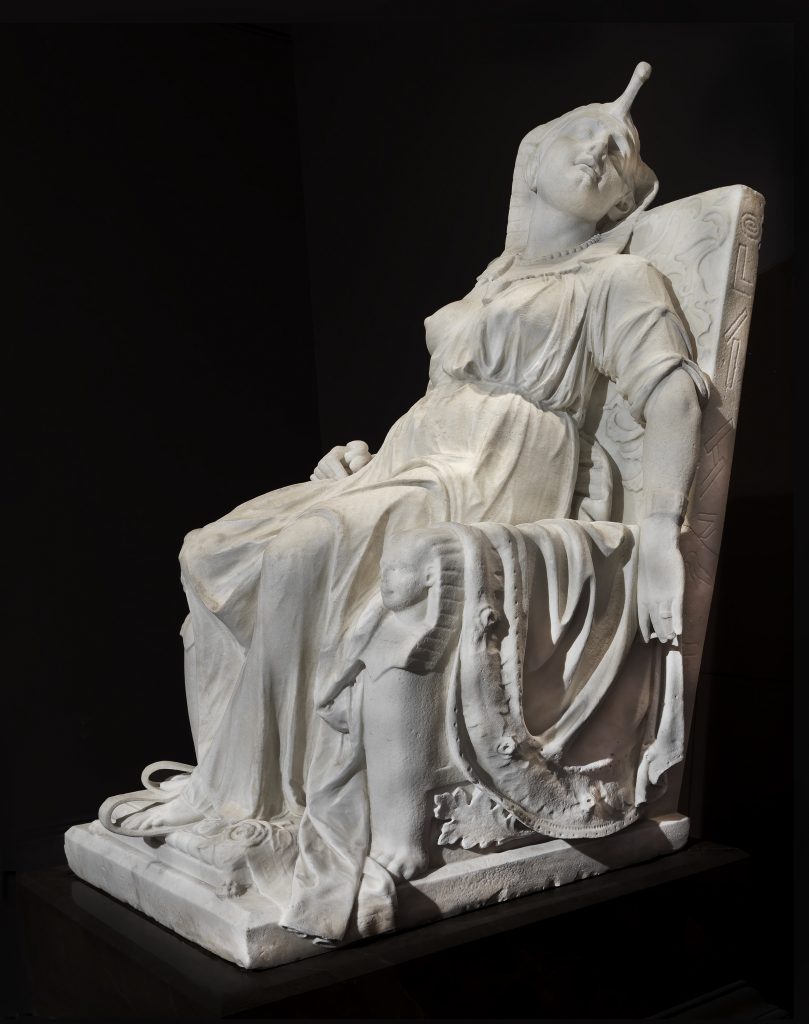
The Death of Cleopatra was Edmonia Lewis’ most ambitious project: A large marble sculpture (weighing almost 3 tons), completed for the 1876 Centennial exhibition in Philadelphia. I have spent a lot of time trying to figure out what to say about this sculpture, and I am currently working on a scholarly essay. I will sum it up here when it’s done, but for now, here is a video to give you a start. If it sounds a bit like a student presentation, that’s because it started out as one (I gave it in the fall of 2020 in a class in an American Art survey). I no longer agree with some of the things I say here about the “meaning” of the sculpture–in particular, I no longer believe that Lewis’ sculpture is so very different from other Cleopatras of her time. In fact, for the essay I am writing, I focus on why it is that Lewis deliberately created a sculpture that does *not* stand out. (Side note: Recalibrating your thinking is one of the most important and most exhausting parts of doing academic research.) But the video is still accurate on the fact; it gives you the basics about the Death of Cleopatra, and then a bit more.
If you are interested in the fascinating afterlife of the Death of Cleopatra, several links in part 2 of the resource section lead to news articles and podcasts that tell its “lost and found” story, and how it ended up in the storage shed of a mall in Illinois in the late 1980s. It had sat for many years in wind and weather, and if you study the high-resolution images the Smithsonian American Art Museum provides up close, you can see the weather damage that has destroyed what would have once been a highly polished marble surface.
Your Turn
I am curious: I usually write blogs and feel awkward about “vlogs” or video presentations. Did you like the short overview in video form? What are the advantages and disadvantages of a written blog post as opposed to a video presentation like this? Do you have a preference?
(Disclaimer: this is not a professionally produced video! It was intentionally made with simple tools that are widely available: a slide show with a–slightly angsty–voiceover, which could be recorded with any simple recording software. I used Zoom’s screen sharing and video recording function, but there are many free applications that work the same way. I apologize I did not include CC captioning. I am still learning.)
What a wonderful job you have done here! I applaud you for all of it. I am a sort-of-sculptor, mostly wood, female, and almost 80, but in no way even close to this woman’s skill. I had never heard of her until I read Smithsonian’s current (recent?) article on her.
The oddest thing for me – I could not find the snake; perhaps the lighting makes it difficult to see.
Snake or no snake, thank you so much for this video, and I wish you all good things in your career!.
Thank you, Polly. I really appreciate hearing from you and your attention to detail! From what I have read (not having seen the sculpture in person, which would make it clearer), the extensive damage to the sculpture while displayed outdoors for decades and then improperly stored included the snake’s head. If you zoom in on the frontal image at the Smithsonian, you can see that she is holding something in her right hand, the one that is resting on her thigh, and that is what is left of the snake!
Excellent presentation Ms Anderson [you voice reminds me of Tatiana Anderson – comcast]- I just purchased Black Heritage Stamp of Edmonia Lewis and had never heard of her. I immediately googled to find out who she was!!! Kudos for the presentation!!! It is always a wonderful opportunity to discover excellence and feel really proud of my ancestors contribution to our community and the world!!!!
Thank you so much, Ms. Wilson–I feel honored, and I am so glad you got the stamps! I was so excited about them that got myself enough to last until my holiday mail in December! Edmonia Lewis is definitely someone to be honored and be proud of, and I am glad that the USPS chose her this year!
I purchased the Edmonia Lewis stamps in late June and sent one on a letter to a friend. She asked me if I knew why Lewis was chosen for a postage stamp. I did not. Oh my goodness, from reading about Edmonia Lewis to listening to your presentation I now know why Edmonia Lewis was chosen for the honor. I taught for 33 years in middle school and had never heard of her. Now I must educate my grandchildren. Isn’t it wonderful to learn!
Thank you so much! I am so glad. I had not ever heard of her until I started to study art history 4 years ago–after teaching college English for over two decades. It is wonderful to learn!
I learned of Edmonia Lewis only after a google search as I make it a point to purchase Black heritage postal stamps and she appeared as one of the figures. Not only did I learn of Miss Lewis in greater detail but I learned even more about Cleopatra and the many interpretations of her death and life. I look forward to visiting the Smithsonian Museum in DC where I assume it yet is exhibited?
Thank you.
Thank you, Ms. Green! I am glad you found out about Edmonia Lewis through the stamps! I have not gone to see the Death of Cleopatra at the Smithsonian, but I know the work is currently on exhibit–and it is on my bucket list to go see it. I am working on a more detailed discussion of this sculpture this year, because the 19th century was so fascinated by Cleopatra.